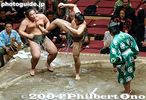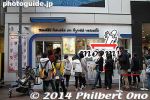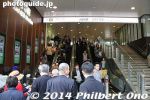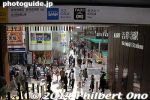 Image search results - "musa" Image search results - "musa" |

Ryogoku Kokugikan sumo arena as seen from Ryogoku Station
|
|

Crowd outside the Kokugikan await their favorite wrestlers.
|
|

Crowd enters the Kokugikan for Musashimaru's retirement ceremony on Oct. 2, 2004.
|
|

Passing out programs
|
|

Musashimaru at the entrance
|
|

Musashimaru greets the crowd
|
|

Hawaii's last sumo wrestler shakes hands.If he were married, his wife would be beside him.
|
|

Musashimaru right after I shook his hand.
|
|

Signboard for retirement ceremony at entrance.It reads "Musashimaru, Intai Danpatsu Hiroo Ozumo" which means "Musashimaru Topknot-Cutting and Retirement Sumo Exhibition."
|
|

Musa-juku was the sixty-sixth of the sixty-nine stations or shukuba post towns on the Nakasendo Road. It is the seventh Nakasendo station in Shiga (following Echigawa-juku in Aisho). MAPMusa was one of ten Nakasendo stations in Shiga. There is very little left. Near Ohmi Railways Musa Station, a short ride from Omi-Hachiman.
|
|

Musashigawa stablemaster (former Yokozuna Mienoumi) in the entrance hallInside the entrance hallway, there was a long table on the left side with ribbons which served as name tags for distinguished guests. Musashigawa is the name of Musashimaru's sumo stable.
|
|

Entrance hall is clogged up by a side show of hula.
|
|

Musashigawa Stable wrestlers greet visitorsIncludes Miyabiyama and Musoyama.
|
|

In the entrance hall, hula and Hawaiian music direct from Hawaii
|
|

The retirement ceremony had a lot of Hawaiian touches. This was only the beginning.Hula dancers and live Hawaiian band from Hawaii.
|
|

Konishiki also sings. (His company arranged the entertainment.)
|
|

Musashigawa Stable wrestler wearing Aloha-print yukataFlowery pattern (plumeria) with "Musashimaru" imprinted.
|
|

Musashimaru souvenirs at the Kokugikan's souvenir shop
|
|

Musashimaru merchandise
|
|

Musashimaru doll
|
|

Site of Musa-juku's Honjin, the town's exclusive lodging for VIPs to stopover or rest. Only the gate remains.
|
|

Giant painted pictures of Musashimaru decorating the arena inside. Each one commemorates a tournament victory.These giant pictures are actually black-and-white photographs taken in a photo studio and printed on large paper. Then it is hand-painted in color by a woman who has been doing it for years.
|
|

The ceremony opens with taiko drum beating on the sumo ring.
|
|

Sumo exhibition matches with lower division Makushita wrestlers.A retirement ceremony for an important sumo wrestler includes a variety of activities besides the actual ceremony of cutting away the topknot. It involves almost the entire Japan Sumo Association, and most wrestlers in the top three divisions (Makushita, Juryo, and Makunouchi) also appear in exhibition matches.
|
|

Makushita sumo matchLower-division wrestlers wear black belts, while the upper division wrestlers wear white belts (during practice) or colored belts during official matches.
|
|

Juryo Division dohyo-iri ring-entering ceremony
|
|

Juryo sumo match
|
|

Hairdressing demonstration
|
|

Sumo match with kidsA retirement ceremony for an important sumo wrestler includes a variety of activities besides the actual ceremony of cutting away the topknot. It involves almost the entire Japan Sumo Association, and most wrestlers in the top three divisions (Makushita, Juryo, and Makunouchi) also appear in exhibition matches.
|
|

A retirement ceremony for an important sumo wrestler includes a variety of activities besides the actual ceremony of cutting away the topknot. It involves almost the entire Japan Sumo Association, and most wrestlers in the top three divisions (Makushita, Juryo, and Makunouchi) also appear in exhibition matches.
|
|
|

Musa's Honjin
|
|

The kids gradually get bigger.
|
|

Ozeki Musoyama is defeated.
|
|

Yobidashi wearing Aloha-print garb
|
|

Comic sumo (shokkiri sumo)This is comedy time with two young wrestlers performing various comical antics (spitting at each other, kicking, and other illegal sumo acts) on the ring.
|
|

Comic sumo (shokkiri sumo)This is comedy time with two young wrestlers performing various comical antics (spitting at each other, kicking, and other illegal sumo acts) on the ring.
|
|

Tidying up the ring
|
|

Musashimaru finally appears for a yokozuna belt demo
|
|

Musashimaru acknowledges a spectator as he proceeds to the ring.This was a demonstration on how they tie on the thick, white rope (tsuna) around his waist. The tsuna is the symbol of the yokozuna. It takes several assistants to put it on. They are all wearing white gloves.
|
|

Yokozuna "tsuna" belt demo
|
|

They wrap the rope around his waist from the front, or the thickest part of the rope.This was a demonstration on how they tie on the thick, white rope (tsuna) around his waist. The tsuna is the symbol of the yokozuna. It takes several assistants to put it on. They are all wearing white gloves.
|
|

Honjin sign
|
|

Pulling it tight
|
|
|
|

Tying the rope at the back.
|
|

Rear view of the shiranui style of tying the rope.He turned in all four directions to show everyone what it looked like. This is what is called the shiranui style of tying the rope. It is characterized by a single loop in the back. The other style, called unryu, has twin loops.
|
|

Musashimaru goes back and then comes back...
|
|

He performs his last yokozuna dohyo-iri ring-entering ceremony. He is flanked by Musoyama on the left as the sword bearer, and Miyabiyama on the right as the dew sweeper.
|
|

Musashimaru's final dohyo-iriHe could have had Yokozuna Asashoryu be either the sword bearer or dew sweeper, but he chose to have his stablemates to join his final dohyo-iri.
|
|

Musashimaru's final dohyo-iri
|
|

Musashimaru's final dohyo-iri
|
|

Musashimaru's final dohyo-iri
|
|

Hatago inn called Nakamura-ya, this was the only remaining inn in Musa-juku. Unfortunately, this inn was destroyed by an early morning fire on Dec. 10, 2010. No one was hurt. The inn owners were sleeping on the 1st floor and they escaped.
|
|

Musashimaru's final dohyo-iri ends
|
|

He goes back to the dressing room
|
|

Sumo jinkuThey are singing sumo jinku, a chant-like song about sumo and sumo wrestlers. They are singing about Musashimaru and his career.
|
|

Laying the red carpet for the main event.
|
|

This must be a first, a kumu hula (hula teacher) from Hawaii performing on the sumo ring.He is Sonny Ching, a well-known hula teacher in Hawaii. He brought four male hula dancers who danced at the four corners of the ring.
|
|

Kumu hula Sonny Ching beats the ipu gourd drum, a traditional Hawaiian instrument. This must be a first, a kumu hula performing on the sumo ring in Japan.
|
|

Male hula dancer at one cornerThe original plan was for the hula dancers to perform on the ring itself. But at the last minute, Musashimaru decided that it was not appropriate so they danced outside the ring.
|
|

Calling Musashimaru (with a conch shell)
|
|

Here he comes...
|
|

Head supporter speaks
|
|

Inn sign. The 200-year-old Nakamura-ya inn burned down on Dec. 10, 2010.
|
|

The chair
|
|

The scissors (golden)I think it was given by French President Chirac who is a sumo fan.
|
|
|

Snip by actor Hiroshi Fujioka, who played Kamen Rider in the '70s.
|
|

Oh, I gotta take a picture of this...Look at the gyoji referee who must be thinking, "C'mon, hurry up!"
|
|

Snip by singer Shigeru MatsuzakiFamous for his classic hit, "Ai no Memory."
|
|

Konishiki is called and he enters
|
|

Snip and a hug by Konishiki (Question: Where was Akebono??)
|
|

Snip by Musashimaru's brother
|
|

More blood relatives (or brothers)
|
|

Musa-juku 武佐宿
|
|

Snip by Kitanoumi, the head of the Japan Sumo Association
|
|

Snip by Yokozuna Asashoryu and a symbolic passing of the baton from one foreign yokozuna to the next (and only) foreign yokozuna.Mongolia's Golden Age of Sumo has begun.
|
|

Snip by stablemate Ozeki Musoyama
|
|

He was grim-faced all throughout
|
|

Panoramic shot of the KokugikanNotice the upper floor was quite empty, similar to Akebono's retirement ceremony.
|
|

Awaiting the final cut as we listen to one of his famous matches.
|
|

The final cut by stablemaster Musashigawa Oyakata.
|
|

Musashimaru minus his topknot
|
|

The End of Hawaii's Golden Age in sumo. For the first time since 1968, no wrestler from Hawaii is in the top Makunouchi division.
|
|

Nephews give a flower bouquet (they can step on the sumo ring)
|
|

Hiroshige's woodblock print of Musa-juku (67th post town on the Nakasendo) from his Kisokaido series. A bridge of boats.
|
|

His mom is next...
|
|

But his mom cannot step on the sumo ring...Females are prohibited from entering the sumo ring. Barring women from stepping onto the sumo ring, even to give an award to a wrestler, is one of the most blatant and preposterous forms of sexual discrimination in Japan. It was devised centuries ago, and for the sake of tradition, traditionalists in the sumo world have maintained this extremely absurd custom and belief that women are considered to be impure (due to menstruation). I'm not saying this as a gaijin (foreigner) who likes to criticize Japan or the Japanese. Nor am I saying this as a women's rights advocate. I say this from the standpoint of plain, old common sense.
Up to 1909, women were actually not allowed enter a sumo arena to view sumo matches. And once upon a time, women were prohibited from setting foot on sacred Mt. Fuji. Can you imagine if these traditions were still being practiced today?
Such discriminatory practices were abolished long ago, and here we are in the 21st century with women still unable to step into the sumo ring. The Japan Sumo Association has constantly rejected requests from important female ministers in the Prime Minister's Cabinet to give an award to the tournament winner in the sumo ring.
|
|

Musashimaru and his flowersThis was his last appearance at this retirement ceremony.
|
|

Makunouchi dohyo-iriNext was exhibition sumo matches by the top-division Makunouchi wrestlers. Musashimaru never appeared again.
|
|

Makunouchi dohyo-iri
|
|

Makunouchi dohyo-iri
|
|

Makunouchi dohyo-iri
|
|

Makunochi dohyo-iri ring-entering ceremony
|
|

Yokozuna Asashoryu performs his dohyo-iri ring-entering ceremony
|
|

Taiko drum demonstration
|
|

"Robocop" Takamisakari gets readyThe top-division Makunouchi wrestlers went through their matches quickly.
|
|

Takamisakari wins
|
|

Final match of the day with Yokozuna Asashoryu
|
|

Asashoryu in the face-off
|
|

Asashoryu later won
|
|

Yumitori-shiki bow-twirling ceremony
|
|

Exiting the building
|
|
|
|

Held on the last weekend of Oct., Dedara Matsuri is a two-day festival held on a large plot of land that used to be Nissan's vehicle assembly plant. Short bus ride from JR Tachikawa Station.From JR Tachikawa Station’s Kitaguchi North exit, go to Bus Stop 1. Board any bus and get off at O-minami Itchome (大南一丁目). About 15 min. ride. From the bus stop, 1 min. walk to entrance.
|
|

Musashi-Murayama (pop. 70,000) is an obscure city in western Tokyo with no train stations, but it is near JR Tachikawa Station in neighboring Tachikawa.
|
|

The festival site occupies an area of a much larger plot of land that was the site of Nissan's auto factory. Along with a few other factories, Nissan closed its vehicle assembly plant here in 2001.I was told that it also had a test track here, which explains why it's so huge. Interesting that Nissan had a policy of keeping all its affected workers who were transferred to other jobs or offered early retirement. The city itself did not suffer much tax loss since Nissan didn't have taxable profits while operating in the red at the time. But local businesses such as taxi drivers, restaurants, and shops must've suffered.
|
|

The festival is highlighted by this Nebuta float depicting Dedara-botchi (also called Daidara-botchi 大多羅法師) who was a legendary, giant man whose head was above the clouds.
|
|

Dedara-botchi is famous for creating lakes and wells with his footprints and creating and carrying mountains.
|
|

In Muasashi-Murayama, the giant Dedara-botchi was carrying Mt. Jodo (浄土山) strapped to his back with vines. One of his footprints created a local well (still there).
|
|

The Dedara-botchi giant man is common in Japan appearing in nation-building legends. For example, where he dug up the earth to create Mt. Fuji (Japan's highest mountain) became Lake Biwa (Japan's largest lake).
|
|

Since it was windy, a crane and cable secured the float.
|
|

Dedara giant Nebuta float is made of a wooden frame covered with washi paper and lit up on the inside powered by power generator.s
|
|

The float was lit up as it got dark.
|
|
|

The festival site includes many food booths. It's a local festival started in 2006 and not a traditional matsuri (i.e. not held by a shrine or temple). But it's the city's largest festival. Not famous though.
|
|

Food booth
|
|

Curry booth with a curry rice humanoid sculpture.
|
|

Festival headquarters.
|
|

The festival site's ground is rough with large pebbles.
|
|

Local dancers perform near the Dedara Nebuta float.
|
|
|
|

Since the festival was on the site of the former Nissan car factory where they manufactured some of Nissan's most famous models, a classic car group displayed their classic Nissan cars.
|
|

Beautifully restored 1961 Nissan Prince Skyline.
|
|
|

Fins on a beautifully restored 1961 Nissan Prince Skyline.
|
|
|
|
|
|

1963 Datsun Fairlady (predecessor to the 240Z) still undergoing restoration.
|
|

1963 Datsun Fairlady (predecessor to the 240Z) still undergoing restoration.
|
|

Toyota Corolla
|
|

Watching the stage entertainment was a good way to kill time until 7 pm when the Dedara Nebuta float parade would start.
|
|

Local lion dance called Yokonakaba shishimai (横中馬獅子舞) dating from 300 years ago.
|
|
|
|

Musashi-Murayama lion dance called Yokonakaba shishimai (横中馬獅子舞) dating from 300 years ago.
|
|
|
|
|
|
|
|
|
|
|
|

Dedara Nebuta float lit up.
|
|

Dedara Nebuta float lit up. It remained stationary.
|
|
|
|
|

The festival climax was this evening parade of small Nebuta floats. After parading in city streets in the late afternoon, they entered the festival site and paraded within the festival grounds while passing by the stationary Dedara Nebuta float.
|
|

Murayama-to float (武士団・村山党) was flanked by people dressed as samurai and ninja. Murayama-to was one of seven samurai groups in this region.
|
|

Murayama-to float with ninja.
|
|
|

Murayama-to Nebuta float.
|
|

Murayama-to Nebuta float and other floats were displayed before the start of the evening parade at 7 pm.
|
|

This small Nebuta shows a Dedara building an extension of the nearby monorail (from Tachikawa) to the city.
|
|

They really want the monorail to be extended to their city so they can finally have a rail station in their city.
|
|
|
|

This Nebuta float (慈王波亜来) was from Mutsu, Aomori.
|
|

The rosary was made of foam balls.
|
|

Back of Nebuta float (慈王波亜来) from Mutsu, Aomori.
|
|

High school taiko drummers (南多摩高校).
|
|
|
|
|

First time to see a taiko drummer in yukata.
|
|

Taiko drummer in yukata.
|
|

Evening parade started at 7 pm with some dancers.
|
|
|
|

Floats and dancers paraded by the Dedara Nebuta float.
|
|
|
|
|
|
|
|
|
|
|
|

Evening parade at 7 pm to 8 pm along the perimeter of the festival site. The parade did not leave the festival site.
|
|
|

The man in the middle is the city's mayor.
|
|
|
|
|
|
|
|
|
|
|
|
|
|
|
|
|
|
|
|
|
|
|
|
|
|
|
|

Buses back to JR Tachikawa Station are numerous until 11:18 pmFestival pamphlet: http://www.dedara.com/files/148/puroguramuura.pdf
https://www.facebook.com/DedaraMusamura
|
|
|
|
|

JR Kichijoji Station platform. Kichijoji is easily accessible on the JR Chuo Line from Shinjuku, Ochanomizu, Kanda, Tokyo Station, etc.
|
|
|

JR Kichijoji Station central entrance
|
|

Inokashira Line entrance. Kichijoji is also accessible from Shibuya Station.
|
|
|
|

Sakura decoration
|
|

JR Kichijoji Station north side
|
|
|
|
|
|

Kichijoji bus
|
|
|

Kichijoji Sunroad, Kichijoji's main shopping arcade. サンロード
|
|

Kichijoji Sunroad サンロード
|
|

Kichijoji Sunroad サンロード
|
|

Kichijoji Sunroad サンロード
|
|

Motomachi-dori
|
|
|
|

A long line of people waiting to buy croquette at a well-known shop.
|
|
|
|
|

Start of the line, what they are waiting for.
|
|

What people are waiting in line for. Didn't buy the famous croqeutte, but bought some meatballs and they were good. Still warm.
|
|

More shopping. Kichijoji is like one big shopping area, anchored by three major dept. stores.
|
|
|
|
|
|
|

Moonmin shop
|
|

Kichijoji Art Museum
|
|
|
|
|

Yodobashi-Kichijoji megastore for cameras and electronics. One of the largest stores in Tokyo. This used to be Kintetsu Dept. Store.
|
|

Yodobashi-Kichijoji megastore for cameras and electronics.
|
|

Temple
|
|

South exit
|
|
|

Inokashira Line tracks overhead.
|
|

South exit for Inokashira Park.
|
|

Going to OIOI (Marui).
|
|

South side of Kichijoji Station
|
|
|

Park Road shopping arcade on south side of Kichijoji Station.
|
|
|
|